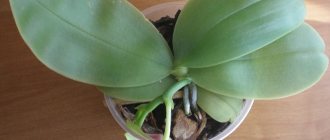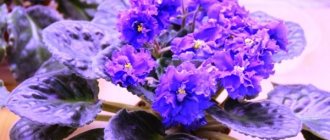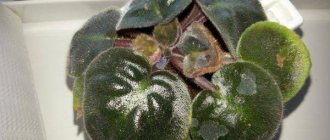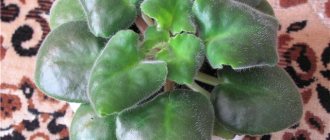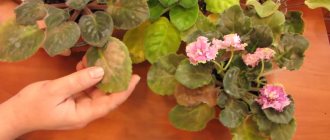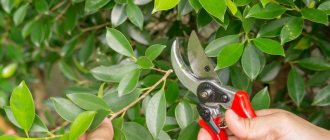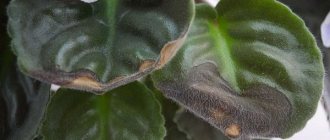Homemade violet is not a fashionable flower, but it is infinitely dear. The plant is a symbol of home, comfort and kinship. It contains our childhood, caring grandparents, and the continuity of the human race.
Scientific name: Saintpaulia. It's hard to imagine, but it was selected from wild violets growing in the African mountains. Its other name is Uzambara violet.
This is not to say that she is difficult to care for. But, as a rule, growing it raises many questions for beginning gardeners.
One of the most common problems is violet leaves curling inward or downward. This phenomenon can be caused by several reasons:
- The indoor air is too dry;
- Draft;
- Excessive watering;
- Pest damage;
- Unsuitable soil for the plant;
- Too much fertilizer.
To save the plant, it is necessary to correctly determine the cause and solve the problem.
Indoor air is too dry
Most often, this problem can be encountered in winter, during intensive operation of heating devices or in very hot summers. Violet loves humidity at 45-50%. And if there is not enough moisture in the air, the plant will look lethargic and the stem will become soft. The leaves will curl.
How to increase air humidity:
- You can purchase a special device to monitor the humidity level in your home. But you can understand that the air in the room is too dry even without a measuring device by your own well-being: a person will feel the need to drink, his hands and lips will dry out, there will be a feeling of stuffiness and a desire to open the window.
- The simplest solution is to buy a humidifier. The device is easy to use and inexpensive. It will easily solve the problem of dry air, which will benefit not only plants, but also people.
- You can solve the problem in another way: place the flower pot on a tray with water or damp sphagnum moss; large tree bark soaked in water will also work.
Draft
If there is a draft in the room and the violet is in the path of cold air, then curling of the leaves may be a consequence of hypothermia.
This reason is the easiest to eliminate. You just need to move the pot with the plant away from the open window.
Special stands with installed lighting for indoor flowers have appeared on sale. This is especially true in autumn and winter, when plants do not have enough sunlight. Such a stand will allow the plant to be located not only on the windowsill, but also in any other place in the house where it will not be oppressed by drafts and there will be sufficient lighting. Uzambara violet can bloom all year round, as long as there is enough light.
Reminder for a newbie!
Uzambara (Uzumbar) violet is a plant of the Gesneriaceae family, growing in the natural environment of tropical and subtropical regions of Asia, Africa, Eastern Australia, South America and the Indian Ocean islands.
Saintpaulia is a plant named after the Saint-Paul father and son, who brought a plant unknown to Europeans from the Uzambara district (modern Tanzania) in the 19th century, presented for the first time at the international flower exhibition in Ghent in 1893.
Indoor violet has been one of the most popular plants in indoor floriculture since 1927. By 1949, more than 100 varieties had been bred, and today their number exceeds several thousand.
Rooting
- possibly in water, in substrate, moss.
Priming
- purchased soil or a mixture of leaf, coniferous, turf and peat soil in a ratio of 3:1:2:1 with the addition of raising agents (perlite, vermiculite, river sand, crushed sphagnum moss.
Lighting - it is best to place flower pots on western or eastern windows. To ensure that the plant is evenly illuminated from all sides, the pots are periodically rotated. In winter, when daylight hours decrease, you can use artificial lighting - fluorescent lamps.
Caring is a real art and serious painstaking work at the same time, including watering, fertilizing, and creating a favorable humid climate. Water Saintpaulias as the soil dries. The soil must be moistened regularly, but excess moisture should not stagnate in the roots. When watering, you must ensure that water does not get on the leaves. You cannot water the Uzambara violet with cold water. Fertilizing is done with complex mineral fertilizer once every two weeks. Saintpaulia reacts negatively to a lack of nitrogen in the soil. Optimal air humidity is approximately 50%, temperature is 20-22 ° C, without sudden fluctuations and drafts. The leaves of the plant should not touch the window glass. Removal of faded flowers and damaged leaves is carried out regularly.
Overwatering
Inward curled leaves and lethargy of the plant can mislead the grower. The first thought with such symptoms is lack of watering. But the violet does not tolerate excess water in the soil; it is better to slightly underwater it than to overfill it. Excess water is dangerous due to root rot and plant death. The roots are not visible and if you make a mistake, the reason for the loss of the plant may become obvious too late.
Unsuitable soil
Saintpaulia needs light and loose soil with good breathability. The soil should not be heavy so that there is no stagnation of water.
I recommend watching the video (be sure to watch it to the end), you will learn a lot of new things:
The ideal soil for violets is a mixture of coarse sand, peat, humus, pine litter, pieces of charcoal or bark. There is a special soil for the plant on sale.
If the cause is the wrong soil, then it is easy to identify and correct. Unfortunately, sometimes the soil is unscrupulous, but it is absolutely not suitable for the plant.
Saintpaulia is a very responsive and sensitive crop; it will tell you that the soil is not suitable for it within a few days after replanting or initial planting. Lighten the soil with sand or charcoal; you can use expanded clay to replant Saintpaulia.
What to do if violet leaves curl?
- View the full image
Violet leaves curl
Reasons for curling leaf blades
Restoring violets after overwatering
Fight against cyclamen mite
Correct selection of soil for violets
Violets are delicate beauties that have been decorating our homes for a very long time. These fragile plants are quite demanding in terms of care and watering. Sometimes the owner begins to notice that the leaves of the violet curl, and the plant stops blooming and its growth slows down. What does this condition of the leaves mean, how to deal with it?
Excess fertilizer
Curling of leaves can cause excess nitrogen and phosphorus.
Fertilizers do not always benefit the plant. There are few rules for using fertilizers, but they exist:
- Do not fertilize too small, young plants;
- Do not feed plants after transplanting into purchased soil (3 months), since it already contains fertilizers;
- Do not fertilize flowers during the dormant period;
- It is forbidden to use fertilizers when the flower is sick;
- Do not pour a solution with vitamins and minerals onto dry soil.
If there is an excess of fertilizers, at best, the flower will become sick: it will become sluggish, the leaves will curl, spots or stains will appear that are unusual for the flower (yellow, burgundy, blue). In the worst case, you can burn the root system.
If there is an excess of fertilizers or a painful reaction to them on the part of Saintpaulia, you can try pouring it with warm water several times so that the water washes away the excess substances, and leave it at rest for 10 days.
If fertilizers have been applied incorrectly or repeatedly, and the Saintpaulia is in a very painful condition, then a transplant will be needed.
Important! If the fertilizer is used for the first time, then first use half the dosage specified in the instructions. After application, it is necessary to observe the reaction of Uzambara violet to mineral substances.
Nitrogen fertilizers are used only in the spring during the period of active growth. Phosphorus and potassium - in the fall or after the end of flowering, but not immediately, but after 2 weeks.
Possible causes of curling
First, you should check the soil moisture, because Saintpaulia often reacts to excessive watering by bending the leaf edge down. If irrigation is carried out correctly and at the recommended frequency, and the violet curls its leaves, then you need to look for pests. The most common infestation of Saintpaulia is the cyclamen mite, which is difficult to see with the naked eye.
If the leaves of a violet curl upward, you need to analyze the quality of lighting and the amount of fertilizing. Curling of foliage can occur as a reaction to direct sunlight. And excessive fertilization of the flower does more harm than good.
If problems begin after transplantation and the leaves turn slightly upward, their source should be sought in an incorrectly selected substrate that is not sufficiently breathable.
Overwatering
If Saintpaulia begins to look sluggish, the bush loses its elasticity, the stems droop, and the leaves curl up, the reason lies in excess moisture.
Inexperienced gardeners often mistake these symptoms for signs of insufficient irrigation and simply begin to flood the plant, inevitably leading to its death.
To distinguish waterlogging from lack of moisture, you need to pay attention to the following signs:
- Saintpaulia looks wilted, but the soil surface is moist;
- Water constantly flows out of the drainage holes;
- Small roots begin to rot.
Cyclamen mite
Pests are the most common reason why indoor violet leaves curl. The cyclamen mite settles on the lower part of the leaves and feeds on the sap of the plant. Pests can spread to violets from other indoor flowers, since their habitat is quite extensive. High humidity promotes the spread of the parasite.
The main symptoms of damage to a houseplant by the cyclamen mite:
- young rosettes are deformed;
- there is a loss of the ability to bloom when all formed buds wither and fall off;
- growth and development stops;
- violet leaves curl downwards, not up;
- excessive fringe develops, from a distance it may seem that the bushes are covered with dust;
- the stems begin to twist.
Excess fertilizer
Violet leaves curl upward when there is excess nitrogen in the soil. Its accumulation occurs with frequent and abundant feeding.
To confirm your suspicions about excessive fertilization, you need to pay attention to the number of stepsons. Often, high nitrogen content in the soil will result in a large increase in sprout production.
Wrong soil
If the leaves curl up into a tube after changing the soil, it means that its composition is chosen incorrectly. When transplanting, there is also a risk of damage to the fragile root system of the flower, which also leads to a change in the top.
Pests
The main enemy of Saintpaulia is mites. They are almost invisible to the human eye, but are capable of destroying a flower completely in 2-3 weeks. When curling the leaves inward, you must carefully examine the plant, preferably using a magnifying glass. It is necessary to check the condition of the sheet plates from the inside and outside.
You should be wary if you notice the following signs:
- Rolling leaves inward;
- Feeling of a slight coating on the leaves or excessive pubescence;
- Increased fragility of stems;
- The presence of small dots of any color on the outside or inside of the leaves;
- The spots on the inside of the leaves are usually brown;
- If there are buds, they do not open, but immediately fall off;
- When you feel the leaves, you can feel compactions;
- Stopping plant growth.
If there are 2-3 signs, it is ticks. It is difficult to get rid of these pests, and this can only be done with a mild primary attack. It is necessary to use specialized preparations - Fitoverm, Agrovertin or Neoron. Several treatments will be required.
Getting rid of pests is the most difficult task. It is not easy to cure violet. It is better to try to prevent infection. Use expert advice:
- Keep new plants separate from other indoor flowers in quarantine for 2 weeks;
- Do not place cut roses and Saintpaulias nearby;
- At the slightest sign of disease, carefully inspect the plant in the near future;
- Don't place multiple pots too close to each other;
- If possible, monitor the room temperature, it is advisable that it should not be higher than +25 degrees;
- Humidify the air; ticks love it when it's hot and dry.
Curling of the leaves inward is an important sign for the owner that not all is well with Saintpaulia. And don't ignore this warning. Violet is not capricious, but she really loves attention and care. She will thank you for this with almost continuous flowering and her extraordinary positive and warm energy.
Corrective Action
Now we have figured out the main reasons for leaf curling, now we just need to learn how to eliminate them.
Eliminating the consequences of the flood
The first thing to do when a flood occurs is to carefully transfer the violet to another pot with drier soil. In this case, it is necessary to cut out all rotten places on the root system. If the symptoms of flooding have just begun to develop, you can get by by drying the earthen clod and loosening it.
You should also check for drainage holes. To prevent flooding in the future, you need to follow these simple rules:
- Water only after the top layer of soil has dried out.
- Watering is best done from a tray
- After watering, be sure to drain excess water from the tray.
Fighting ticks
The cyclamen mite is a rather dangerous and difficult to remove pest. Its destruction must be approached comprehensively. The first thing to do is isolate the infected plant. It should be noted right away that it will most likely not be possible to save a very heavily infected violet.
The next thing to do is to remove all severely damaged leaves on the plant. After this, treatment with special acaricide preparations begins. For example, in indoor conditions you can use Fitoverm. There is no point in using traditional insecticides against ticks; they will be ineffective in combating them.
Video on how to fix problems with violets:
Restoring the lighting and fertilizer regime
For successful development, violets require soft, diffused lighting. If this condition is violated, its leaves begin to deform. When keeping plants under lamps, the duration of daylight hours should not exceed 12 hours. And the lamps themselves should be located above the plants at a height of 25-30 cm.
The fastest way to eliminate overfeeding is to transfer it to fresh soil. To prevent this from happening in the future, it is best to purchase a special substrate for growing violets.
When applying fertilizers, you should strictly observe the required dosage and frequency of use. When using universal mineral fertilizers for feeding, it is recommended to reduce their dosage by half.
